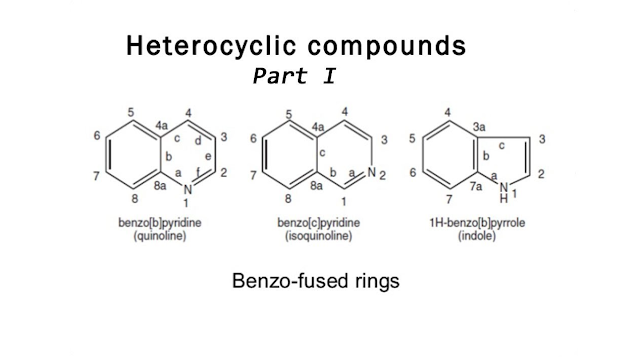Heterocyclic compounds are cyclic compounds with the ring containing carbon and other elements, the commonest being oxygen, nitrogen and sulphur. There are a number of heterocyclic_rings which are easily opened and do not possess any aromatic properties, e.g., ethylene oxide, y- and 6-lactones, etc. These are not considered to be heterocyclic compounds. Heterocycles are those compounds with five- or six-membered heterocyclic rings which are stable, contain conjugated double bonds, and exhibit aromatic character.
Nomenclature:
Many heterocyclic systems have trivial names (see text). The following is the systematic method of nomenclature.
(i) The names of monocyclic compounds are derived by a prefix (or prefixes) indicating the nature of the hetero-atoms present, and eliding the 'a' where necessary, e.g., oxygen, oxa: sulphur, thia; nitrogen, aza; silicon, sila; phosphorus, phospha. When two or more of the same hetero-atoms are present, the prefixes di, tri, etc. are used, e.g., dioxa, triaza. If the hetero-atoms are different, their order of citation starts with the hetero-atom of as high a group in the periodic table and as low an atomic number in that group. Thus, the order of naming will be 0, S, N, P, Si, e.g., thiaza (S then N).
(ii) The sitze of a monocyclic ring from 3 to 10 is indicated by a stem: 3, it (tri); 4, et (tetra); 5, of ; 6, in; 7, ep (hepta); 8, oc (octa); 9, on (nona); 10, ec (deca) [see Table 30.1] .of ; 6, in; 7, ep (hepta); 8, oc (octa); 9, on (nona); 10, ec (deca) [see Table 30.1] .
(iii) The state of hydrogenation is indicated in the suffix (see Table 30.1), or by the prefixes dihydro, tetrahydro, etc., or by prefixing the name of the parent unsaturated compound with the symbol H preceded by a number indicating the position of saturation.
(iv) (a). In a monocyclic compound containing only one hetero-atom, numbering starts at this atom. (b) The ring is numbered to give substituents or other hetero-atoms the lowest numbers possible. If the hetero-atoms are different, then numbering starts at the atom cited firstaccording to the rule in (i) and proceeds round the ring in order of precedence.



0 Comments